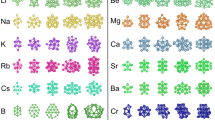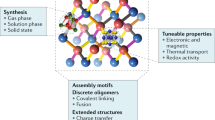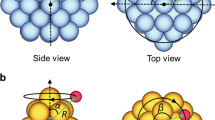Abstract
Silicon is the most important semiconducting material in the microelectronics industry. If current miniaturization trends continue, minimum device features will soon approach the size of atomic clusters. In this size regime, the structure and properties of materials often differ dramatically from those of the bulk. An enormous effort has been devoted to determining the structures of free silicon clusters1,2,3,4,5,6,7,8,9,10,11,12,13,14,15,16,17,18,19,20,21,22. Although progress has been made for Sin with n < 8, theoretical predictions for larger clusters are contradictory2,3,4,5,6,7,8,9,10,11,12,13,14,15,16,17,18,19,20,21,22 and none enjoy any compelling experimental support. Here we report geometries calculated for medium-sized silicon clusters using an unbiased global search with a genetic algorithm. Ion mobilities23 determined for these geometries by trajectory calculations are in excellent agreement with the values that we measure experimentally. The cluster geometries that we obtain do not correspond to fragments of the bulk. For n = 12–18 they are built on a structural motif consisting of a stack of Si9 tricapped trigonal prisms. For n ⩾ 19, our calculations predict that near-spherical cage structures become the most stable. The transition to these more spherical geometries occurs in the measured mobilities for slightly larger clusters than in the calculations, possibly because of entropic effects.
This is a preview of subscription content, access via your institution
Access options
Subscribe to this journal
Receive 51 print issues and online access
$199.00 per year
only $3.90 per issue
Buy this article
- Purchase on Springer Link
- Instant access to full article PDF
Prices may be subject to local taxes which are calculated during checkout



Similar content being viewed by others
References
Pacchioni, G. & Koutecky, J. Silicon and germanium clusters. A theoretical study of their electronic structures and properties. J. Chem. Phys. 84, 3301–3310 (1986).
Tomanek, D. & Schluter, M. A. Calculation of magic numbers and the stability of small Si clusters. Phys. Rev. Lett. 56, 1055–1058 (1986).
Slee, T., Zhenyang, L. & Mingos, D. M. P. Polyhedral skeletal electron pair theory of bare clusters. 1. Small silicon clusters. Inorg. Chem. 28, 2256–2261 (1989).
Chelikowsky, J. R., Glassford, K. M. & Phillips, J. C. Interatomic force fields for silicon microclusters. Phys. Rev. B 44, 1538–1545 (1991).
Phillips, J. C. Electron-correlation energies and the structure of Si13. Phys. Rev. B 47, 14132–14135 (1993).
Vasiliev, I., Ögüt, S. & Chelikowsky, J. R. Ab Initio calculations for the polarizabilities of small semiconductor clusters. Phys. Rev. Lett. 78, 4805–4808 (1997).
Raghavachari, K. & Rohlfing, C. M. Bonding and stabilities of small silicon clusters: a theoretical study of Si7–Si10. J. Chem. Phys. 89, 2219–2234 (1988).
Rohlfing, C. M. & Raghavachari, K. Atheoretical study of small silicon clusters using an effective core potential. Chem. Phys. Lett. 167, 559–565 (1990).
Raghavachari, K. & Rohlfing, C. M. Structures of Si10. Are there conventionally bonded low-energy isomers? Chem. Phys. Lett. 198, 521–525 (1992).
Messmer, R. P. & Patterson, C. H. Long bonds in silicon clusters: a failure of conventional Møller-Plesset perturbation theory? Chem. Phys. Lett. 192, 277–282 (1992).
Mistriotis, A. D., Froudakis, G. E., Vendras, P. & Flytzanis, N. Model potential for silicon clusters and surfaces. Phys. Rev. B 47, 10648–10653 (1993).
Jug, K. & Krack, M. Consistent parameterization of semiempirical MO methods. Int. J. Quant. Chem. 44, 517–531 (1992).
Gu, B., Li, Z. & Zhu, J. Electrical structure of small icosahedral silicon clusters. J. Phys.: Condens. Matter 5, 5255–5260 (1993).
Gong, X. G., Zheng, Q. Q. & He, Y. Z. Structural properties of silicon clusters: an empirical potential study. J. Phys.: Condens. Matter 7, 577–584 (1995).
Menon, M. & Subbaswamy, K. Nonorthogonal tight-binding molecular-dynamics scheme for silicon with improved transferability. Phys. Rev. B 55, 9231–9234 (1996).
Ramakrishna, M. V. & Bahel, A. Combined tight-binding and density functional molecular dynamics investigation of Si12cluster structure. J. Chem. Phys. 104, 9833–9840 (1996).
Wales, D. J. Electronic structure of small silicon clusters. Phys. Rev. A 49, 2195–2198 (1994).
Kaxiras, E. & Jackson, K. Shape of small silicon clusters. Phys. Rev. Lett. 71, 727–730 (1993); Structural models for intermediate-sized Si clusters. Z. Phys. D 26, 346–348 (1993).
Pederson, M. R., Jackson, K., Porezag, D. V., Hajnal, Z. & Frauenheim, T. Vibrational signatures for low-energy intermediate-sized Si clusters. Phys. Rev. B 54, 2863–2867 (1996).
Grossman, J. C. & Mitas, L. Quantum Monte Carlo determination of electronic and structural properties of Sinclusters. Phys. Rev. Lett. 74, 1323–1326 (1995); Family of low-energy elongated Sin(n ≤ 50) clusters. Phys. Rev. B 52, 16735–16738 (1995).
Rothlisberger, U., Andreoni, W. & Giannozzi, P. Thirteen-atom clusters: equilibrium geometries, structural transformations, and trends in Na, Mg, Al, and Si. J. Chem. Phys. 96, 1248–1256 (1992).
Song, J., Ulloa, S. E. & Drabold, D. A. Soliton-induced lattice relaxation and the electronic and vibrational spectra of silicon clusters. Phys. Rev. B 53, 8042–8051 (1996).
Jarrold, M. F. & Constant, V. A. Silicon cluster ions: evidence for a structural transition. Phys. Rev. Lett. 67, 2994–2997 (1991).
Arnold, C. C. & Neumark, D. M. Study of Si4and Si−4using threshold photodetachment (ZEKE) spectroscopy. J. Chem. Phys. 99, 3353–3362 (1993).
Honea, E. C.et al. Raman spectra of size-selected silicon clusters and comparison with calculated structures. Nature 366, 42–44 (1993).
Li, S., Van Zee, R. J., Weltner Jr, W. & Raghavachari, K. Si3-Si7. Experimental and theoretical infrared spectra. Chem. Phys. Lett. 243, 275–280 (1995).
Von Helden, G., Hsu, M. T., Gotts, N. G. & Bowers, M. T. Carbon cluster cations with up to 84 atoms: structures, formation mechanism, and reactivity. J. Phys. Chem. 97, 8182–8192 (1993).
Mesleh, M. F., Hunter, J. M., Shvartsburg, A. A., Schatz, G. C. & Jarrold, M. F. Structural information from ion mobility measurements: effects of the long-range potential. J. Phys. Chem. 100, 16082–16086 (1996).
Deaven, D. M. & Ho, K. M. Molecular geometry optimization with a genetic algorithm. Phys. Rev. Lett. 75, 288–291 (1995).
Jarrold, M. F. Drift tube studies of atomic clusters. J. Phys. Chem. 99, 11–21 (1995).
Shvartsburg, A. A., Hudgins, R. R., Dugourd, Ph. & Jarrold, M. F. Structural elucidation of fullerene dimers using high-resolution ion mobility measurements and trajectory calculation simulations. J.Phys. Chem. A 101, 1684–1688 (1997).
Bylaska, E. J., Taylor, P. R., Kawai, R. & Weare, J. H. LDA predictions of C20isomerizations: neutral and charged species. J. Phys. Chem. 100, 6966–6972 (1996).
Martin, J. M. L. C28: the smallest stable fullerene? Chem. Phys. Lett. 255, 1–6 (1996).
Acknowledgements
We thank J. Chelikowsky, D. Drabold, G. Froudakis, J. Grossman, K. Jackson, K. Jug, M. Krack, U. Landman, H. Mayne, M. Menon, L. Mitas, L. Munro, K. Raghavachari, C. Rohlfing, K.Subbaswamy and D. Wales for providing us with their optimized silicon cluster geometries and for discussions; we also thank R. Hudgins for assistance with the experimental work. This research was supported by the NSF, the US Army Research Office, the Office of Basic Energy Sciences, the High Performance Computing and Communications initiative (including a grant of computer time at the National Energy Research Supercomputing Center), and Ames Laboratory operated for the US DOE by Iowa State University.
Author information
Authors and Affiliations
Corresponding author
Rights and permissions
About this article
Cite this article
Ho, KM., Shvartsburg, A., Pan, B. et al. Structures of medium-sized silicon clusters. Nature 392, 582–585 (1998). https://doi.org/10.1038/33369
Received:
Accepted:
Issue Date:
DOI: https://doi.org/10.1038/33369
This article is cited by
-
Structural evolution and electronic properties of medium-sized CrSin−/0 (n = 19–25) clusters
Structural Chemistry (2023)
-
Study the structures and electronic properties of CsSin− (n = 5–16) clusters by ab initio global search
Structural Chemistry (2023)
-
Metadynamics sampling in atomic environment space for collecting training data for machine learning potentials
npj Computational Materials (2021)
-
Reactivity between medium-sized silicon cluster and NO2: first principles study
Journal of Molecular Modeling (2021)
-
Solar Driven CO2 Hydrogenation on Ti-Doped Silicon Nanocages
Journal of Cluster Science (2020)
Comments
By submitting a comment you agree to abide by our Terms and Community Guidelines. If you find something abusive or that does not comply with our terms or guidelines please flag it as inappropriate.



